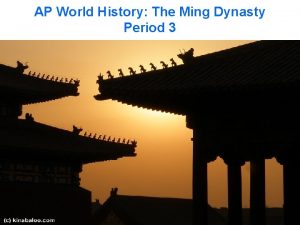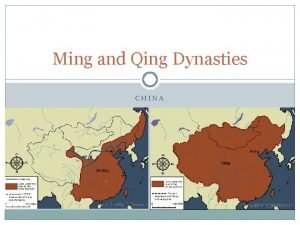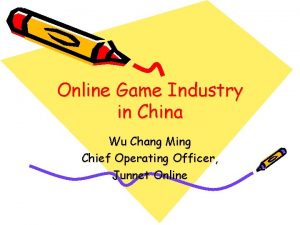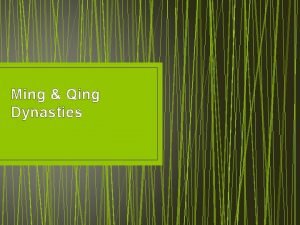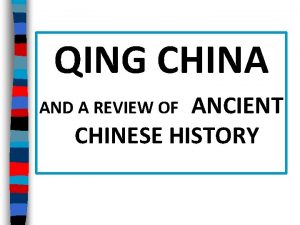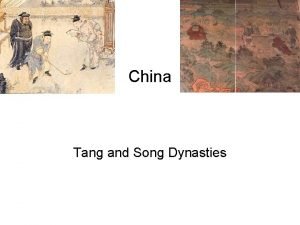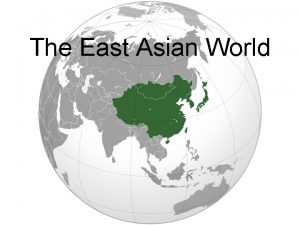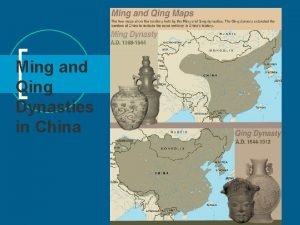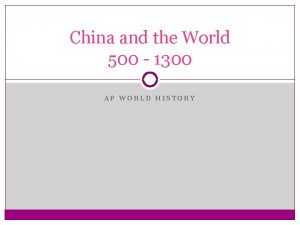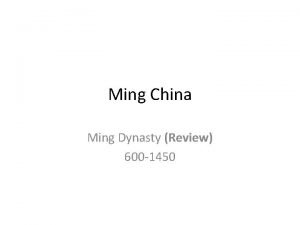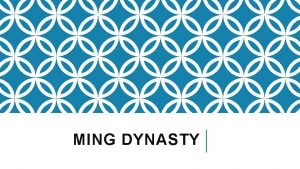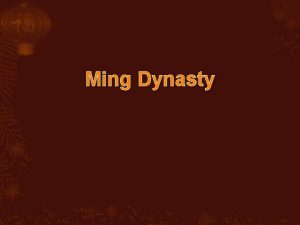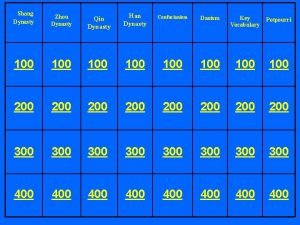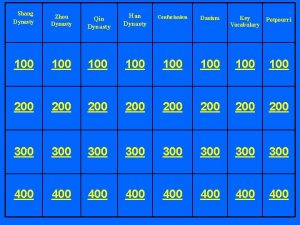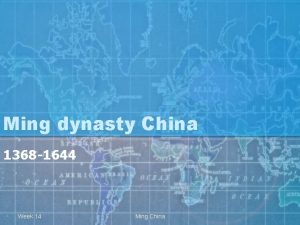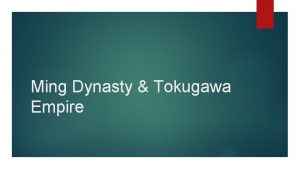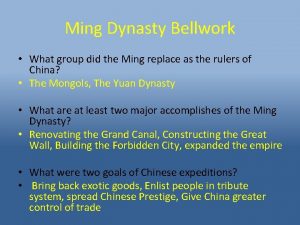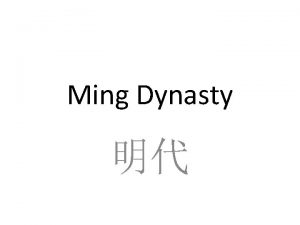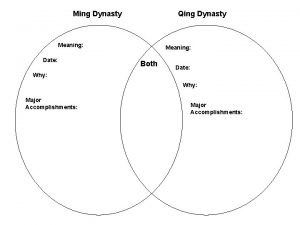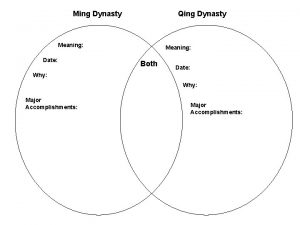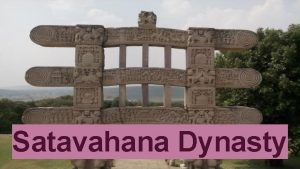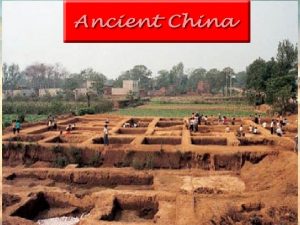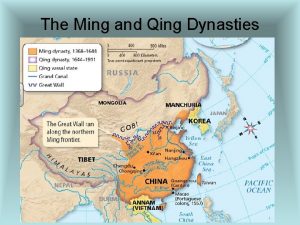AP World History The Ming Dynasty Period 3



















![Model of Zheng He’s Ship We have traversed more than… [30, 000 miles] of Model of Zheng He’s Ship We have traversed more than… [30, 000 miles] of](https://slidetodoc.com/presentation_image_h/85148c5a83b1b81941ab0359b0232841/image-20.jpg)






- Slides: 26

AP World History: The Ming Dynasty Period 3

Timeline of Chinese History Shang Dynasty Zhou Dynasty Warring States • • Shang Dynasty 1650 – 1027 BCE Earliest Chinese river valley civilization Near the Yellow River Earliest form of Chinese writing • Zhou Dynasty 1027 – 256 BCE • Believed Emperors receive the Mandate of Heaven • Warring States 403 – 221 BCE • Conflict between rival dynasties, in the eastern part of the Zhou Dynasty.

Timeline of Chinese History Continued… • • • Qin Dynasty • Qin Dynasty 221 – 207 BCE First centralized government, ruled by an Emperor Philosophy of Legalism Began building the Great Wall of China Han • Han Dynasty 206 BCE – 220 CE • Made Confucianism the official belief system of China • Government workers required to pass a Civil Service Exam, based on Confucianism Sui • Sui Dynasty 589 – 619 CE • Built the Grand Canal Dynasty

Timeline of Chinese History Continued… Tang • Tang Dynasty 618 CE – 907 CE • Invented block printing and moveable type Dynasty Song Dynasty Yuan Dynasty • Song Dynasty 960 CE – 1279 CE • Invented paper currency, mechanical clock, smallpox vaccine • Yuan Dynasty 1279 CE – 1368 CE • China was ruled by the Mongols

I Yuan Dynasty (1279 -1368) A) 1279 Mongol leader Kublai Khan conquered China and began the Yuan dynasty.

Yuan Dynasty (1279 -1368) Continued… B) After the death of Kublai Khan in 1294, the Yuan Dynasty weakened. The Chinese resented Mongol and the discrimination against the Chinese in the government. This led to rebellions. China was once again unified under the Ming Dynasty in 1368.

II The Ming Dynasty (1368 - 1644) A) The Ming Dynasty rid China of the Mongols, and built a new capital at Ying Tian (modern Nanjing). It was later moved to Beijing. B) Revived Civil Service Exam that had been begun under the Han. C) The Ming completed the Great Wall of China, which had begun under the Qin Dynasty, and pushed the Mongols further north to what is now Mongolia. D) Began a policy of expansionism, and state-sponsored trading expeditions. Ming means “brilliant”

III Emperor Yongle “Perpetual Happiness” (ruled 1402 -1424) A) Immediately upon taking the throne, Ming Emperor Yongle executed anyone who opposed him. B) He widened the size of the Grand Canal, to increase trade C) Yongle built the “Forbidden City”, his imperial home, in his capital of Beijing.

The Forbidden City 178 acres 800 buildings, and stables for elephants! Legend says that it has 9, 999 rooms, but there actually 8, 707 Was the home of 24 Ming and Qing Emperors from 1420 – 1911.

Male Lion by the Gate of Celestial Purity


Gilded Unicorn Guarding Hall of Imperial Peace

The 9 Dragon Screen


Doorway

Balustrades

Sunset at the Forbidden City

IV Zheng He’s fleet (1405 - 1433) A) Ming Emperor Yongle desired to send shipsto the west of China. Yongle appointed Zheng He, a trusted official, to command these western voyages. B) Zheng He was Muslim, and a eunuch (castrated for service at the royal court). C) Zheng He led 7 great expeditions, to India, the Middle East, and even Eastern Africa! He led 9 great “treasure ships” with 28, 000 armed troops. D) Confucian scholars resented Zheng He, as Confucianism looks down upon merchants. Unlike later Western European explorers like Vasco de Gama, Zheng He was NOT exploring the unknown; China ALREADY KNEW about ports in India and East Africa. China also did not desire trade; merchants came to China. So what was the real purpose of Zheng He’s trips? To show off the greatness of China, and to bring back exotic luxuries for the Emperor.

How Does Zheng He Compare to Other Explorers? Navigator Number of Ships Number of Crew Zheng He (1405 - 1433) 48 to 317 28, 000 Columbus (1492) 3 90 Da Gama (1498) 4 160 Magellan (1521) 5 265
![Model of Zheng Hes Ship We have traversed more than 30 000 miles of Model of Zheng He’s Ship We have traversed more than… [30, 000 miles] of](https://slidetodoc.com/presentation_image_h/85148c5a83b1b81941ab0359b0232841/image-20.jpg)
Model of Zheng He’s Ship We have traversed more than… [30, 000 miles] of immense water… and have beheld in the ocean huge waves like mountains rising in the sky, and we have set eyes on barbarian regions far away… while our sails, loftily unfurled like clouds day and night… - Zheng He, 1432.


V Chinese Exploration Ends A) 1435 Zheng He died. The new Emperor, Yongle’s son, Hongle, banned any further sea voyages. B) Why did Emperor Hongle ban any further voyages? 1. He believed in Confucianism, that ranked merchants on the lowest scale of society. 2. As the voyages were not for trade, they cost China more money than they brought in.

The Now Shut Starbucks at the Forbidden City

Did the Chinese Beat Out Columbus? By Sonia Kolesnikov-Jessop NY Times Saturday, June 25, 2005 …Zheng, a Chinese Muslim, was captured as a child in wartime by the Ming army and made a eunuch to serve at court. He became a scholar and a trusted adviser to the third Ming emperor, Zhu Di, who sent him on a mission to "proceed all the way to the ends of the earth to collect tribute from the barbarians beyond the seas. " When the giant fleet returned in 1423, however, the emperor had fallen. With that change of leadership, China began a policy of isolationism that would last hundreds of years. The large ships were left to rot at their moorings, and most of the records of the great journeys were destroyed (though some argue the records still exist). With 600 years of sailing experience, the Chinese had already developed many tools useful to sailing over great distances - like magnetized compasses and watertight bulkhead compartments of a kind the West would have to wait hundreds of years for. Importantly, Zheng He's ships, known as junks, included on-board vegetable patches, growing soybeans in tubes all year to provide protein and vitamin C, guarding sailors against scurvy… Arguing that the Chinese had reached America 70 years before Columbus, Menzies's book caused a stir when it was published in 2002. "Columbus had a map of America, de Gama had a map showing India and Captain Cook had a map showing Australia, and it's not my saying; it's the explorers saying it, ”. . .

Did the Chinese Beat Out Columbus? Menzies, who is planning to revise his book by 2007 in light of the latest evidence, now believes that Zheng He was not the first to sail to America. "One of the mistakes I made in my book was to say that Zheng He did everything. He had a legacy. Most of the world had already been mapped by Kublai Khan's fleet, " he said. According to Menzies, recent evidence has been found of what are believed to be wrecked Chinese junks in Florida, South Carolina, New York and Canada. More compellingly, Menzies says, a new archaeological site in Nova Scotia at Cape Dauphin, discovered by the Canadian architect Paul Chiasson and represented by photos at the exhibition, indicates an early Chinese settlement. Chiasson, in an e-mail interview, said, "The position of the wall on the side of the hill (not the summit), the layout of the wall across the hilly topography and the relationship of a small settlement located within the wall to the overall enclosure all point away from a European origin and appeared to point to a Chinese origin. " While some archaeologists argue that the settlement could be Viking, Chiasson disagrees, pointing out that the nearest and largest evidence of any Viking settlement in the area is more than 700 kilometers to the north and that the Vikings were building much smaller outposts than the one discovered. The site has just been surveyed by Cedric Bells, who has also worked on a New Zealand site believed to have Chinese junks. Bells has found canals, smelters, mines, Buddhist tombs, Islamic graves, barracks, all pointing to a very large settlement, Menzies said. "This site is unquestionably Chinese and unquestionably pre-European. I actually believe it's quite possible it was started by Kublai Khan and

Focus Questions 1. What were the main achievements of the Ming Dynasty? 2. Why do you think China stopped longdistance sea voyages? Do you agree with their decision? 3. What evidence is there that Zheng He may have come to America prior to Columbus? If it is proven, how would that change history?
 Ap world
Ap world Ming dynasty time period
Ming dynasty time period East asia spice chart
East asia spice chart Ming dynasty game online
Ming dynasty game online Qing dynasty location
Qing dynasty location The ming dynasty ended rule of china.
The ming dynasty ended rule of china. Ming dynasty trade routes
Ming dynasty trade routes Qing social structure
Qing social structure Tang and song dynasty venn diagram
Tang and song dynasty venn diagram Rise of the ming dynasty
Rise of the ming dynasty Mingoch
Mingoch Ming dynasty
Ming dynasty Sui dynasty definition ap world history
Sui dynasty definition ap world history Apwh period 3
Apwh period 3 Ap world history period 2 test
Ap world history period 2 test Sui tang and song dynasties
Sui tang and song dynasties Ap world history chapter 25 africa and the atlantic world
Ap world history chapter 25 africa and the atlantic world Dangerous world tour history world tour - hockenheimring
Dangerous world tour history world tour - hockenheimring The development of children 7th edition
The development of children 7th edition Absolute refractory period and relative refractory period
Absolute refractory period and relative refractory period When is the relative refractory period
When is the relative refractory period Critical period vs sensitive period
Critical period vs sensitive period Critical/sensitive periods
Critical/sensitive periods Approaches to child development
Approaches to child development Classical period 1750 to 1820 romantic period
Classical period 1750 to 1820 romantic period Nonmetal, halogen family, atomic mass 35
Nonmetal, halogen family, atomic mass 35 Period of activism meaning
Period of activism meaning
